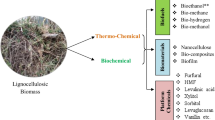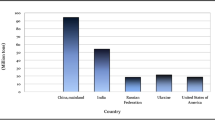Abstract
Besides free sugars, sweet sorghum stalks contain cellulose and hemicellulose that can be used for biofuel production. The pretreatment of stalks without the extraction of free sugars is more complicated than typical lignocelluloses, because of the degradation of free sugars during most pretreatment processes. In this study, the bioconversion of sweet sorghum stalks into biogas and bioethanol was studied using an improved organosolv pretreatment within a biorefinery framework. The organosolv pretreatment was developed using an aqueous solution of ethanol (EtOH) and isopropanol (IPOH). The process was optimized to obtain a liquor containing free sugars with the least sugar degradations together with a highly degradable solid fraction. The liquor was subjected to anaerobic digestion for biomethane production, while the solid was used for ethanol production via simultaneous saccharification and fermentation (SSF). The most influencing pretreatment parameters, i.e., temperature, time, alcohol to water ratio, EtOH to IPOH ratio, and the presence or absence of sulfuric acid (as a catalyst), were adjusted to achieve the highest yields of bioconversion. The maximum methane and ethanol production yields of 271.2 mL CH4/g VS and 87.8% (equal to the gasoline equivalent of 0.170 and 0.241 L/kg, respectively) were achieved from the liquor and pretreated solid, respectively; however, they were obtained at different optimum conditions. Considering the biorefinery perspective, the highest gasoline equivalent of 0.249 L/kg was efficiently obtained from the whole process after pretreatment at 140 °C for 30 min using 60:20 EtOH/IPOH ratio in the presence of 1% sulfuric acid. Further analyses, including enzymatic adsorption/desorption, compositional analysis, FTIR, and SEM, were conducted to investigate the effects of this newly developed pretreatment on the substrate.



Similar content being viewed by others
References
Adney B, Baker J (1996) Measurement of cellulase activities. Lab Anal Proc 6:1996
Almodares A, Hadi M (2009) Production of bioethanol from sweet sorghum: a review. Afr J Agric Res 4(9):772–780
Almodares A, Hadi M, Ahmadpour H (2008) Sorghum stem yield and soluble carbohydrates under different salinity levels. Afr J Biotechnol 7(22)
Amiri H, Karimi K, Roodpeyma S (2010) Production of furans from rice straw by single-phase and biphasic systems. Carbohydr Res 345(15):2133–2138. https://doi.org/10.1016/j.carres.2010.07.032
Arato C, Pye EK, Gjennestad G (2005) The lignol approach to biorefining of woody biomass to produce ethanol and chemicals. In: Twenty-Sixth Symposium on Biotechnology for Fuels and Chemicals, Springer, p 871–882. doi: 10.1007/978-1-59259-991-2_74
Behera S, Arora R, Nandhagopal N, Kumar S (2014) Importance of chemical pretreatment for bioconversion of lignocellulosic biomass. Renew Sust Energ Rev 36:91–106. https://doi.org/10.1016/j.rser.2014.04.047
Briens C, Piskorz J, Berruti F (2008) Biomass valorization for fuel and chemicals production—a review. Int J Chem React Eng 6(1). https://doi.org/10.2202/1542-6580.1674
Carrillo F, Colom X, Sunol J, Saurina J (2004) Structural FTIR analysis and thermal characterisation of lyocell and viscose-type fibres. Eur Polym J 40(9):2229–2234. https://doi.org/10.1016/j.eurpolymj.2004.05.003
DeubleinD, SteinhauserA (2011) Biogas from waste and renewable resources: an introduction. John Wiley & Sons
Dien BS, Jung H-JG, Vogel KP, Casler MD, Lamb JF, Iten L, Mitchell RB, Sarath G (2006) Chemical composition and response to dilute-acid pretreatment and enzymatic saccharification of alfalfa, reed canarygrass, and switchgrass. Biomass Bioenergy 30(10):880–891. https://doi.org/10.1016/j.biombioe.2006.02.004
Gan Q, Allen S, Taylor G (2003) Kinetic dynamics in heterogeneous enzymatic hydrolysis of cellulose: an overview, an experimental study and mathematical modelling. Process Biochem 38(7):1003–1018. https://doi.org/10.1016/S0032-9592(02)00220-0
Goshadrou A, Karimi K, Taherzadeh MJ (2013) Ethanol and biogas production from birch by NMMO pretreatment. Biomass Bioenergy 49:95–101. https://doi.org/10.1016/j.biombioe.2012.12.013
Hallac BB, Sannigrahi P, Pu Y, Ray M, Murphy RJ, Ragauskas AJ (2010) Effect of ethanol organosolv pretreatment on enzymatic hydrolysis of Buddleja davidii stem biomass. Ind Eng Chem Res 49(4):1467–1472. https://doi.org/10.1021/ie900683q
Hansen TL, Schmidt JE, Angelidaki I, Marca E, Jansen JC, Mosbæk H, Christensen TH (2004) Method for determination of methane potentials of solid organic waste. Waste Manag 24(4):393–400. https://doi.org/10.1016/j.wasman.2003.09.009
Harmsen P, Huijgen W, Bermudez L, Bakker R (2010) Literature review of physical and chemical pretreatment processes for lignocellulosic. Biomass:1–49
Hesami SM, Zilouei H, Karimi K, Asadinezhad A (2015) Enhanced biogas production from sunflower stalks using hydrothermal and organosolv pretreatment. Ind Crop Prod 76:449–455. https://doi.org/10.1016/j.indcrop.2015.07.018
Jafari Y, Amiri H, Karimi K (2016) Acetone pretreatment for improvement of acetone, butanol, and ethanol production from sweet sorghum bagasse. Appl Energy 168:216–225. https://doi.org/10.1016/j.apenergy.2016.01.090
Karimi K, Emtiazi G, Taherzadeh MJ (2006) Ethanol production from dilute-acid pretreated rice straw by simultaneous saccharification and fermentation with Mucor indicus, Rhizopus oryzae, and Saccharomyces cerevisiae. Enzym Microb Technol 40(1):138–144. https://doi.org/10.1016/j.enzmictec.2005.10.046
KarimiK, ShafieiM, KumarR (2013) Progress in physical and chemical pretreatment of lignocellulosic biomass. In: GuptaVK, TuohyMG (ed) Biofuel technologies. Springer Berlin Heidelberg, pp 53–96. doi: https://doi.org/10.1007/978-3-642-34519-7_3
Koo B-W, Min B-C, Gwak K-S, Lee S-M, Choi J-W, Yeo H, Choi I-G (2012) Structural changes in lignin during organosolv pretreatment of Liriodendron tulipifera and the effect on enzymatic hydrolysis. Biomass Bioenergy 42:24–32. https://doi.org/10.1016/j.biombioe.2012.03.012
Kumar R, Wyman CE (2008) An improved method to directly estimate cellulase adsorption on biomass solids. Enzym Microb Technol 42(5):426–433. https://doi.org/10.1016/j.enzmictec.2007.12.005
Kumar R, Wyman CE (2009) Access of cellulase to cellulose and lignin for poplar solids produced by leading pretreatment technologies. Biotechnol Prog 25(3):807–819. https://doi.org/10.1002/btpr.153
Lu Y, Yang B, Gregg D, Saddler JN, Mansfield SD (2002) Cellulase adsorption and an evaluation of enzyme recycle during hydrolysis of steam-exploded softwood residues. App Biochem Biotechnol 98(1):641–654. https://doi.org/10.1385/ABAB:98-100:1-9:641
Mirmohamadsadeghi S, Karimi K, Zamani A, Amiri H, Sárvári Horváth I (2014) Enhanced solid-state biogas production from lignocellulosic biomass by organosolv pretreatment. Biomed Res Int 2014:1–6. https://doi.org/10.1155/2014/350414
Mitchell VD, Taylor CM, Bauer S (2014) Comprehensive analysis of monomeric phenolics in dilute acid plant hydrolysates. Bioenergy Res 7(2):654–669. https://doi.org/10.1007/s12155-013-9392-6
Ostovareh S, Karimi K, Zamani A (2015) Efficient conversion of sweet sorghum stalks to biogas and ethanol using organosolv pretreatment. Ind Crop Prod 66:170–177. https://doi.org/10.1016/j.indcrop.2014.12.023
Pan X, Xie D, Yu RW, Saddler JN (2008) The bioconversion of mountain pine beetle-killed lodgepole pine to fuel ethanol using the organosolv process. Biotechnol Bioeng 101(1):39–48. https://doi.org/10.1002/bit.21883
Poornejad N, Karimi K, Behzad T (2013) Improvement of saccharification and ethanol production from rice straw by NMMO and [BMIM][OAc] pretreatments. Ind Crop Prod 41(1):408–413. https://doi.org/10.1016/j.indcrop.2012.04.059
Safari A, Karimi K, Shafiei M (2017) Dilute alkali pretreatment of softwood pine: a biorefinery approach. Bioresour Technol 234:67–76. https://doi.org/10.1016/j.biortech.2017.03.030
SluiterA, HamesB, HymanD, PayneC, RuizR, ScarlataC, SluiterJ, TempletonD, WolfeJ (2008) Determination of total solids in biomass and total dissolved solids in liquid process samples National Renewable Energy Laboratory, Golden, CO, NREL Technical Report No NREL/TP-510-42621
Taherzadeh MJ, Karimi K (2008) Pretreatment of lignocellulosic wastes to improve ethanol and biogas production: a review. Int J Mol Sci 9(9):1621–1651. https://doi.org/10.3390/ijms9091621
TaherzadehMJ, KarimiK (2011) Fermentation inhibitors in ethanol processes and different strategies to reduce their effects. In: Pandey A (ed) Biofuels, alternative feedstocks and conversion processes, Elsevier Science & Technology, pp 287–311. doi: 10.1016/B978-0-12-385099-7.00012-7
WortmannCS, RegassaT (2011) Sweet sorghum as a bioenergy crop for the US Great Plains Economic Effects of Biofuel Production. InTech
Zhao X, Cheng K, Liu D (2009) Organosolv pretreatment of lignocellulosic biomass for enzymatic hydrolysis. Appl Microbiol Biotechnol 82(5):815–827. https://doi.org/10.1007/s00253-009-1883-1
Acknowledgements
The authors are grateful to Dr. Abbas Almodares (Department of Biological Science, University of Isfahan, Iran) for providing the sweet sorghum stalks and Novozymes, Denmark, for providing Cellic® HTec2 and Cellic® CTec2 enzymes for this study.
Funding
This study was supported by the Research Institute for Biotechnology and Bioengineering, Isfahan University of Technology, and Iran National Science Foundation (INSF, Grant No. 95003713).
Author information
Authors and Affiliations
Corresponding authors
Ethics declarations
Conflict of interest
The authors declare that they have no conflict of interest.
Ethical approval
This article does not contain any studies with human participants or animals performed by any of the authors.
Electronic supplementary material
ESM 1
(PDF 539kb)
Rights and permissions
About this article
Cite this article
Nozari, B., Mirmohamadsadeghi, S. & Karimi, K. Bioenergy production from sweet sorghum stalks via a biorefinery perspective. Appl Microbiol Biotechnol 102, 3425–3438 (2018). https://doi.org/10.1007/s00253-018-8833-8
Received:
Revised:
Accepted:
Published:
Issue Date:
DOI: https://doi.org/10.1007/s00253-018-8833-8




